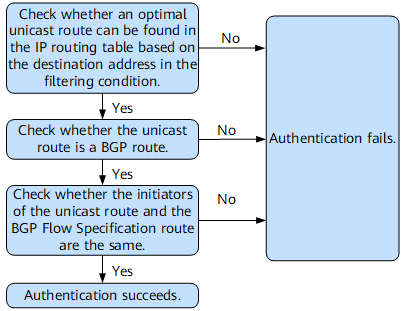Configuring Dynamic BGP FlowSpec
BGP FlowSpec routes are generated by a traffic analysis server in dynamic BGP FlowSpec.
Usage Scenario
When deploying dynamic BGP FlowSpec, a BGP FlowSpec peer relationship needs to be established between the traffic analysis server and each ingress of the network to transmit BGP FlowSpec routes.
In an AS with multiple ingresses, a BGP Flow route reflector (Flow RR) can be deployed to reduce the number of BGP FlowSpec peer relationships and save CPU resources.
If you want to filter traffic matching a specified address prefix but BGP FlowSpec routes matching the specified address prefix fail to be authenticated, disable the authentication of the BGP FlowSpec routes received from a specified peer.
Procedure
- Configure a BGP FlowSpec peer relationship.
- (Optional) Configure a Flow RR.
Before configuring a Flow RR, establish a BGP FlowSpec peer relationship between the Flow RR with the traffic analysis server and every network ingress.
- (Optional) Add the AS_Path attribute as a check item to BGP Flow Specification route verification rules.
- (Optional) Disable BGP FlowSpec route authentication.
- (Optional) Disable an EBGP peer from validating the received routes that carry a redirection extended community attribute.
- (Optional) Configure a BGP peer to process the received routes that carry the redirection next-hop IPv6 address, color, and prefix SID attributes.
- (Optional) Configure the redirection next-hop attribute ID for BGP Flow Specification routes.
The redirection next-hop attribute ID can be 0x010C (defined in a related RFC) or 0x0800 (defined in a related draft). If a Huawei device needs to communicate with a non-Huawei device that does not support the redirection next-hop attribute ID of 0x010C or 0x0800, set the redirection next-hop attribute ID of BGP Flow Specification routes as required. Perform one of the following configurations based on the ID supported by non-Huawei devices:
Set the redirection next-hop attribute ID to 0x010C (defined in a related RFC) for BGP Flow Specification routes.
- Run system-view
The system view is displayed.
- Run bgp as-number
The BGP view is displayed.
- Run ipv4-family flow
The BGP-Flow address family view is displayed.
- Run peer ipv4-address redirect ip rfc-compatible
The redirection next-hop attribute ID of the BGP Flow Specification route is set to 0x010C (defined in a related RFC).
- Run commit
The configuration is committed.
- Run system-view
Change the redirection next-hop attribute ID of BGP Flow Specification routes to 0x0800 (defined in a related draft).
- Run system-view
The system view is displayed.
- Run bgp as-number
The BGP view is displayed.
- Run ipv4-family flow
The BGP-Flow address family view is displayed.
- Run peer ipv4-address redirect ip draft-compatible
The redirection next-hop attribute ID of BGP Flow Specification routes is changed to 0x0800 (defined in a related draft).
- Run commit
The configuration is committed.
- Run system-view
- (Optional) Configure the interface in the BGP Flow Specification as the traffic-injection interface of the cleaned traffic to prevent the injected traffic from matching the Flow Specification rules and being switched back to the cleaning device.
- (Optional) Disable BGP Flow Specification on the interface.
- (Optional) Allow the device to recurse the received routes that carry a redirection extended community attribute to tunnels.
- (Optional) Allow the device to recurse received routes with the next-hop IPv6 address, color attribute, and prefix SID attributes to tunnels.
- (Optional) Configure BGP FlowSpec for packets with a specified IP address sent to the public network.
- (Optional) Enable the CAR statistics and packet
loss statistics function for BGP Flow Specification.
- (Optional) Enable BGP FlowSpec for packets that have entered the VXLAN tunnel.
- (Optional) Enable BGP FlowSpec on a GRE tunnel interface.
- (Optional) Disable BGP FlowSpec protection.
- (Optional) Enable BGP Flow Specification IPv4 fragmentation rules to comply with RFC 5575.
Verifying the Configuration
Run the following commands to verify the previous configuration.
Run the display bgp flow peer [ [ ipv4-address ] verbose ] command to check information about BGP FlowSpec peers.
Run the display bgp flow routing-table command to check BGP FlowSpec routing information.
Run the display bgp flow routing-table [ peer ipv4-address ] [ advertised-routes | received-routes [ active ] ] statistics command to check BGP FlowSpec route statistics.
Run the display flowspec statistics reindex command to check statistics about IP packets matching a specific BGP FlowSpec route for BGP FlowSpec protocol protection on interfaces in a specified interface group.
- Run the display flowspec rule reindex-value slot slot-id command to check information about combined rules in the BGP FlowSpec local rule table.
- Run the display flowspec rule statistics slot slot-id command to check statistics about the rules for BGP FlowSpe routes to take effect.

